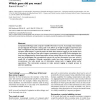948 search results - page 18 / 190 » How People use Words to Make Meanings |
NIPS
2008
13 years 10 months ago
2008
We use graphical models and structure learning to explore how people learn policies in sequential decision making tasks. Studies of sequential decision-making in humans frequently...
COST
2009
Springer
13 years 6 months ago
2009
Springer
Synchrony is claimed by psychology as a crucial parameter of any social interaction: to give to human a feeling of natural interaction, a feeling of agency [17], an agent must be a...
ICRA
2010
IEEE
13 years 7 months ago
2010
IEEE
Abstract— For many tasks in populated environments, robots need to keep track of present and future motion states of people. Most approaches to people tracking make weak assumpti...
BMCBI
2005
13 years 8 months ago
2005
Computational Biology needs computer-readable information records. Increasingly, meta-analysed and pre-digested information is being used in the follow up of high throughput exper...
NN
2006
Springer
13 years 8 months ago
2006
Springer
Many of our daily activities are supported by behavioural goals that guide the selection of actions, which allow us to reach these goals effectively. Goals are considered to be im...

